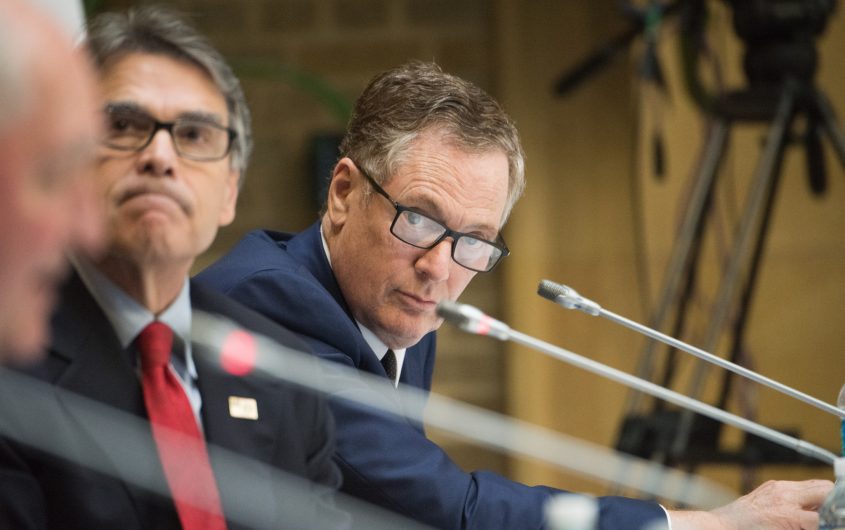
U.S. Department of Agriculture via Flickr
USTR Reveals Its Hand on U.S.-EU Trade

Peter S. Rashish
Vice President; Director, Geoeconomics Program
Peter S. Rashish, who counts over 30 years of experience counseling corporations, think tanks, foundations, and international organizations on transatlantic trade and economic strategy, is Vice President and Director of the Geoeconomics Program at AICGS. He also writes The Wider Atlantic blog.
Mr. Rashish has served as Vice President for Europe and Eurasia at the U.S. Chamber of Commerce, where he spearheaded the Chamber’s advocacy ahead of the launch of the Transatlantic Trade and Investment Partnership. Previously, Mr. Rashish was a Senior Advisor for Europe at McLarty Associates, Executive Vice President of the European Institute, and a staff member and consultant at the International Energy Agency, the World Bank, UNCTAD, the Atlantic Council, the Bertelsmann Foundation, and the German Marshall Fund.
Mr. Rashish has testified before the House Financial Services Subcommittee on International Monetary Policy and Trade and the House Foreign Affairs Subcommittee on Europe and Eurasia and has advised three U.S. presidential campaigns. He has been a featured speaker at the Munich Security Conference, the Aspen Ideas Festival, and the Salzburg Global Seminar and is a member of the Board of Directors of the Jean Monnet Institute in Paris and a Senior Advisor to the European Policy Centre in Brussels. His commentaries have been published in The New York Times, the Financial Times, The Wall Street Journal, Foreign Policy, and The National Interest, and he has appeared on PBS, CNBC, CNN, NPR, and the BBC.
He earned a BA from Harvard College and an MPhil in international relations from Oxford University. He speaks French, German, Italian, and Spanish.
At his meeting with European Commission President Jean-Claude Juncker in July of last year announcing the launch of U.S.-EU trade talks, President Trump called it a “very big day for free and fair trade.” Now, nearly six months later, with the unveiling last Friday by the Office of the U.S. Trade Representative (USTR) of its negotiating objectives for these talks, we can begin to get an idea of how big a day it was (or not).
It is tempting to compare what USTR wants to achieve this time around with its ambitions for the Transatlantic Trade and Investment Partnership (TTIP) that was launched in 2013 and ultimately negotiated to a standstill in the fall of 2016 under the Obama administration. Then, a letter from the acting U.S. Trade Representative to the Speaker of the House laying out the White House’s objectives started out rather prosaically (but admirably) by stating its ambition to “eliminate all tariffs and other duties and charges on trade in agricultural, industrial, and consumer products between the United States and the EU…”
The Trump administration takes a different tack, with sentence number one reading “Improve the U.S. trade balance and reduce the trade deficit with the EU.” Instead of aiming to liberalize trade as the Obama White House did, the current one makes its overarching objective to manage trade. That is, to have governments decide in advance how much each economic partner gets to import and export, rather than leave the outcome to the myriad private decisions within the fair and well-regulated transatlantic marketplace.
This is nothing new. Since the beginning, the current administration has wrongly maintained that a) the U.S. bilateral deficit with the EU is unfair and b) that it can be resolved through trade—rather than macroeconomic—policies.
Although that debut is inauspicious, most of what follows should lay a solid groundwork for the talks, even if in parts it is reminiscent of what Mark Twain is reported to have said about Wagner’s music: it’s better than it sounds.
Case in point: while the TTIP letter from the Obama era used the neutral term “seek” to outline its objectives, now USTR isn’t shy about using the word “require” more than once to express its ambitions for the new U.S.-EU talks. But most of things the U.S. would like to require the EU to do are welcome, like adhering to labor and environmental standards.
Overall, USTR sets out several laudable goals, including reining in subsidies and state-owned enterprises (which would be valuable as precedents vis-à-vis China), facilitating the role of small- and medium-sized enterprises in trade, supporting the free flow of digital trade, and promoting regulatory cooperation. Although it lists agriculture among the topics to be discussed, which the EU so far has rejected, USTR also states that it “may seek to pursue negotiations in stages,” meaning that farm issues could be left until the end.
Perhaps most valuable of all is that, along with the upcoming release of the EU negotiating mandate, the announcement of USTR’s objectives will keep the talks moving forward. That means the U.S. administration is unlikely to include the EU in any national security tariffs it may impose on automobile imports once a Commerce Department report on that issue hits the president’s desk next month. If it did so, that would violate the president’s pledge during his meeting with Juncker that “we will not go against the spirit of this agreement, unless either party terminates the negotiation.” So far, the White House has held to this commitment.









